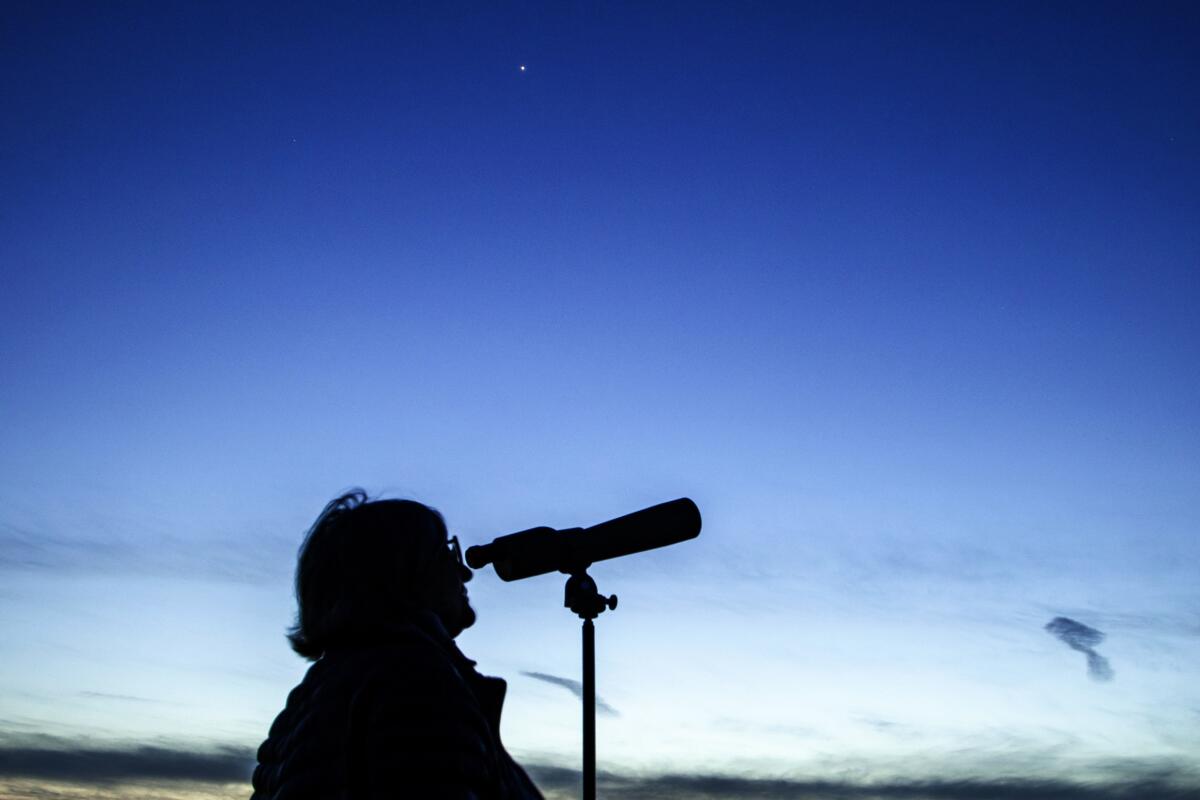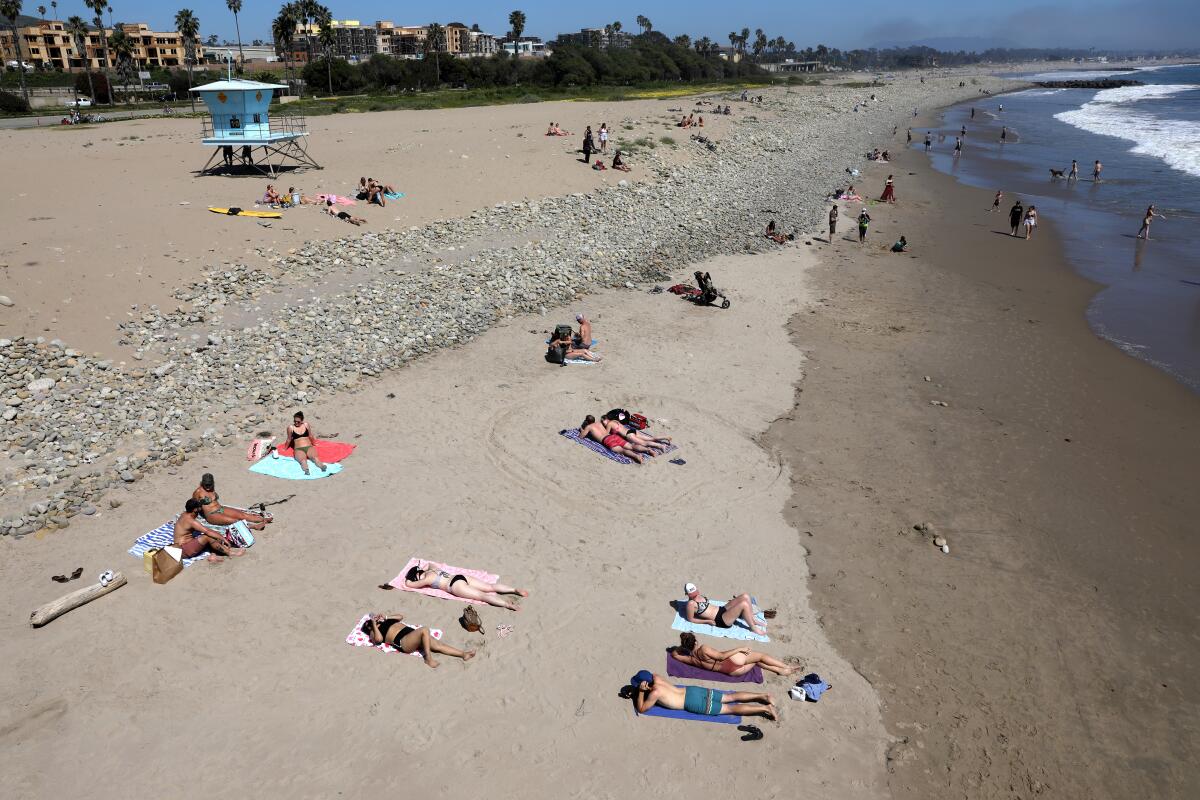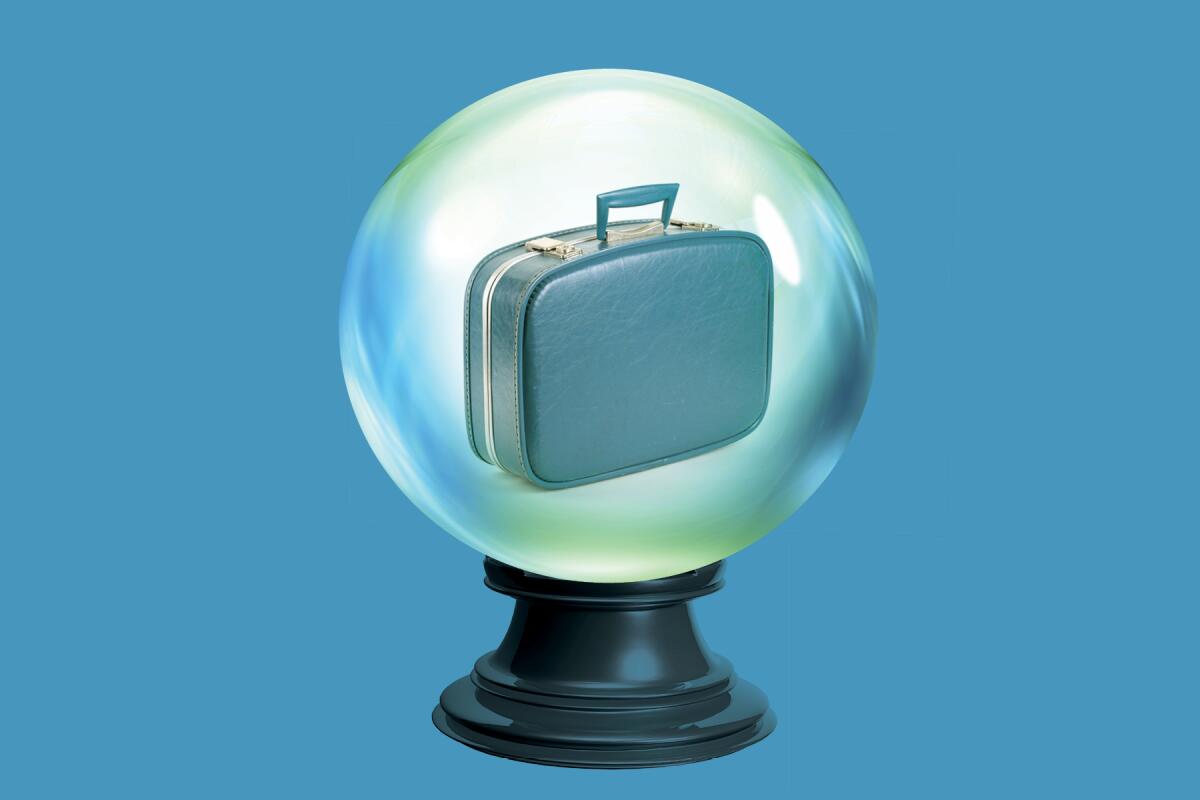Escapes: How to become one with the universe

- Share via
“Outside!”
Kris Milgate’s toddler son wanted to go outside. In the middle of the night. On a camping trip. That didn’t make him especially popular with his bunkmates, including his uncle.
But the boy had experienced the joy of the night sky, and he wanted more.
Get inspired to get away.
Explore California, the West and beyond with the weekly Escapes newsletter.
You may occasionally receive promotional content from the Los Angeles Times.
“I thought he was delirious,” Milgate said in an email. “I know I felt delirious, but I went outside anyway. He settled right down and so did I.
“I turned into a wise parent for a moment, and the stars seemed even better that night.”
The fascination with the night sky continues to this day for that boy, who is now a teenager.
In these times, when things don’t seem to be looking up, looking up may be just what we need.
My name is Catharine Hamm, and I’m the travel editor for the Los Angeles Times. Besides our package on stargazing and night skies (we’ll elaborate below), we also this week have taken a look at the future of travel — what might happen with hotels, flights and cruises. We tell you what’s new around L.A., what is happening and what’s not. And in the end paper, we ponder the cosmic question of what travel really is.
Join us, won’t you?
Tuning in to the music of the night
Here’s a how to. You can:
Watch the sky from your backyard with this advice from Kris Milgate, who also clears up confusion about dark skies designations.
Focus on seven easy-to-find stars and planets to make your first ventures successful, courtesy of Christopher Reynolds.
Take great photos of night skies, using tips from professional photographer but amateur astrophotographer Mark Boster.
Find apps and gear that will help you. Mary Forgione and Christopher Reynolds have some ideas.
Get inspired by space all over again with these sky-centric movies and TV shows recommended by Christopher Reynolds.

What’s open and what’s closed?
Not open: Hawaii, which has extended its stay-at-home order to May 31, Mary Forgione and Jay Jones write. If you go anyway, you’ll be required to self-quarantine for 14 days. Not doing so could mean a fine of up to $5,000 and a year in jail.
Sorta open: Christopher Reynolds gives you the current guide for where you can and cannot go. Keeping up with this shifting landscape isn’t easy, so check before you go.

Boiling Point
The photo above reminds me how unseasonably warm it’s been, and that has me worried in the short term and the long. It’s important to remember, even in the midst of this pandemic, that our planet is threatened by a crisis as well.
Boiling Point is a new Los Angeles Times newsletter that explains the science behind what is happening. And if you’re thinking, “Well, what can I do?” it also will share advice on that.
You can sign up for the weekly newsletter here or in our membership center. Like all our other newsletters, it’s free, and it’s delivered to your inbox. We thank you, and you’ll thank yourself.
Refunds revisited
That’s a common cry from consumers who have been baffled and battered in an effort to get money back from travel they ended up not taking. Your credit card is an excellent tool, but don’t be too quick to draw on it, I write in my On the Spot column.
Enjoying this newsletter? Consider subscribing to the Los Angeles Times
Your support helps us deliver the news that matters most. Become a subscriber.
What does the future of travel look like?
Here’s what we know: Nobody knows for sure. But with help from experts, Christopher Reynolds, Mary Forgione and I have put together three pieces that look at the future of hotels (Reynolds), cruises (Forgione) and flying (me).

What we’re reading
Sure, you’re getting up and dressed every day, but you’re doing it all wrong, Shana Lebowitz and Weng Cheong write for Business Insider. Or, said more deftly, as we’ve learned since being confined with people who are getting downright huffy, you could be treating yourself a little bit better by changing some of your habits. It’s really a kindness to yourself, especially when your snooze alarm is not. It’s also a primer for those times when you’re not at home (remember being away from home? I don’t), especially if you have trouble sleeping when traveling.
On Wednesday, a big asteroid gave our planet a break by not hitting us. But in 1954, Anne Hodges wasn’t as lucky. She was napping when a meteorite smashed through her ceiling and smacked her leg. She survived. Seventy years before that, a man in Iraq was struck and killed, and another man was injured, newly uncovered evidence suggests, in what may be the best documentation of a such a death in history, Sid Perkins writes for Science magazine. Moral of the story? I’m not sure, except that there is something to be said about bad luck, and none of it is good.
In Hokitika, New Zealand, January’s rough seas deliver lots of driftwood, which then becomes the basis for the Driftwood and Sand Festival, Rena Behar writes for Atlas Obscura. Using the abundant detritus, residents (mostly) and others build sculptures — a large hand emerges from the sand, a boat with an angler looks ready, if not totally seaworthy. A good reminder about blooming where we are planted.
For your reading and writing list
The Los Angeles Times, of course. Being a subscriber puts you in the know at a time when you need an indexed package of information. Subscribe here, if you would, please.
Other newsletters. It’s money well spent, because … they’re free! Delivered to your inbox. And, of course, packed with news and charm.
Let us know what you’d like to see more of, less of or none of. Write to us: travel@latimes.com.
Thank you.
End paper
After 9/11, many of us began thinking of travel as a right. Air travel was taken from us for less than a week, and I can remember being heartbroken that I was missing parents’ weekend for my college-age niece whose dad had just died.
It seemed an eternity until flying was an option, never mind a safe one.
This period of no non-essential travel has made me reconsider. I no longer feel as though it’s my right; I think of it now as a privilege.
And, as I told a group of travel journalists and media relations pros the other day, with that privilege comes responsibilities, once we are traveling again:
The world is wounded; it’s our job to help it heal, by our actions and our words.
The world is anxious; it’s our job to reassure, not with a false sense of calm, but rational actions when things don’t go as planned.
The world is shaken; it is our job to reassure, not with platitudes but by listening.
The world is chaotic; it’s our job to solve at least some of the problems, not to be the problem.
The stay-at-home mandate has given us time to regroup and remember how much travel enriches us. When next you travel, please share those riches with the world.
Until then, be well and safe, and when we are on the road again, remember that we will be here to welcome you home.
Sign up for The Wild
We’ll help you find the best places to hike, bike and run, as well as the perfect silent spots for meditation and yoga.
You may occasionally receive promotional content from the Los Angeles Times.




